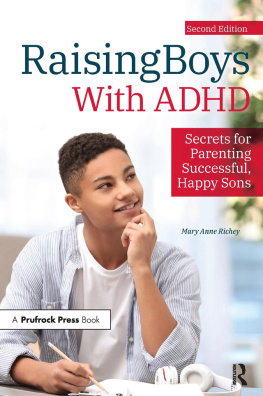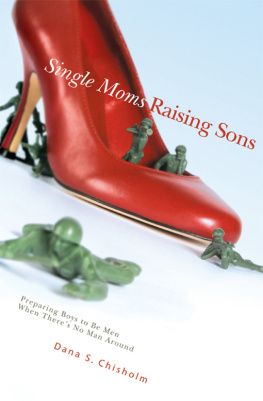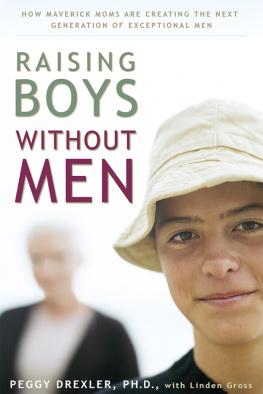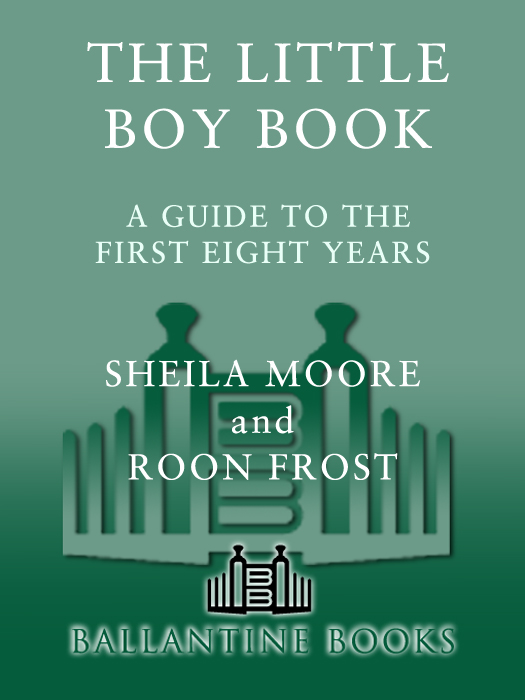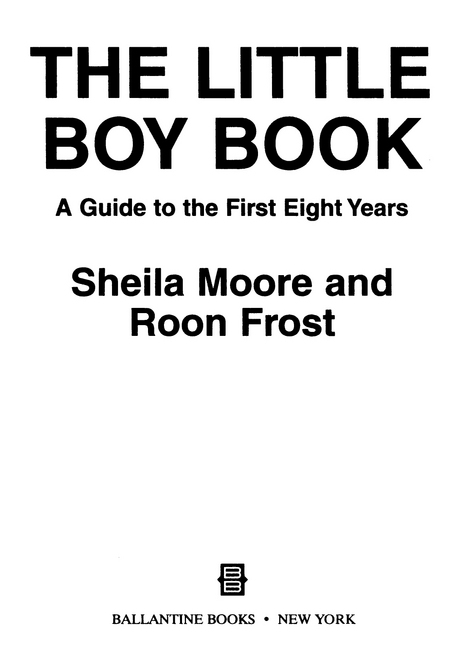FIND THE ANSWER TO THESE QUESTIONS INSIDE:
*Arent boys more aggressive than girls only because we condition them to be so?
*How can parents tell if their son is ready for school?
*Is it harmful for a boy to have a working mother?
*Why is first grade such a critical year in a boys life?
*Is it best for parents to just ignore their son when he is throwing a tantrum?
*Does television violence have equal impact on all children?
*How can a father contribute to his sons emotional stability?
*How can parents help little boys to become good readers?
AND MORE!
Copyright 1986 by Sheila Moore and Roon Frost
All rights reserved.
Published in the United States by Ballantine Books, an imprint of The Random House Publishing Group, a division of Random House, Inc., New York, and simultaneously in Canada by Random House of Canada Limited, Toronto.
B ALLANTINE and colophon are registered trademarks of Random House, Inc.
This edition published by arrangement with Clarkson N. Potter, Inc.
eISBN: 978-0-307-83040-1
www.ballantinebooks.com
v3.1
Contents
3. Learning to Be a Boy
PRESCHOOLERS
5. The Primary School Years
GRADES ONE THROUGH THREE
6. Boys with Special Learning Needs
THE LEARNING DISABLED AND THE GIFTED
7. Of Risk to Boys
DIVORCE, INADEQUATE SUPERVISION, TELEVISION AND ROCK MUSIC, SUBSTANCE ABUSE
Introduction
If you are the parent of a little boy, you may have discovered that the children described in many books for parents are not like your son at all. More often than not, you find information about children in generalnot about boys in particular.
The Little Boy Book is written for parents of sons. Knowing why one boy is so different from otherswhy there is so much variability among boys in generaland why boys may be more vulnerable than their sisters can help us be more responsive as parents. Discovering that there are methods of discipline that work especially well with boysand others that do notcan assist us in making family relationships smoother.
Throughout the book we present a range of positive parenting techniques and tell you where to find more information if you need it; prescriptive sections that deal with particular issues and problems are highlighted. You are interested in methods that work with your little boy, and from the research we have selected findings that we feel will assist you in meeting your sons individual needs.
Both parents and teachers will find the material on learning useful. The sad consequences of pressuring our sons in academic areas at early ages are widespreadschool failure, even of bright middle-class children; an increased incidence of special-education enrollments; and an alarming rise in adolescent suicide. We hope that what you read in The Little Boy Book will cause you to take a second look the next time you read an article about the superbaby who learns to read at two.
We are both mothers of sons with backgrounds in education and journalism. Four years ago we began looking at research on child development, educational methods, and sex differences. We spoke with experts at leading universities and research centers throughout the United States in order to put together the kind of book we wished wed hadone that would complement the child-care books that had been helpful to us, but would also tell parents as much as possible about boys.
Although our book deals with serious issues, we have included drawings by prominent cartoonists that portray the humorous aspects of life with little boys. They reflect the endearing qualities and hilarious antics of boys every parent will recognize.
New findings as well as information seldom included in books for parents will, we believe, give you a clearer understanding of your son. We hope, as well, that you find answers, help, and the satisfaction we experienced in raising our little boys.
Sheila Moore
Roon Frost
July 1985

What Little Boys Are Made Of
I n Huckleberry Finn, Mark Twains novel of American boyhood, Huck and his friend Jim hide away on an island in the Mississippi River. Boredom sets in after several weeks and, in Hucks words, I said it was getting slow and dull, and I wanted to get a stirring up some way I would slip over the river and find out what was going on. Disguising himself as a girl, he rows to shore and approaches a strange house, where a woman invites him inside.
During the visit, Huck attempts to thread a needle. Unlike a girl, who would bring the thread to the needle, Huck tries to do it by bringing the needle to the thread. Suspicious, the woman complains about the number of rats scurrying about the cabin, some so bold as to peek out at her young visitor. She suggests that Huck throw a heavy lead weight at them. Huck throws the weight with his arm out to one sidelike a boy wouldand the woman catches him out.
Why, I spotted you for a boy when you was threading the needle! she exclaims with satisfaction.
* * *
Whether the tasks be threading a needle, throwing a ball, climbing a tree, or learning to write the alphabet, we often notice that boys and girls do them differently. If you have a daughter as well as a son, you can probably list a number of ways they differ in behavior without thinking about it for very long at all.
In Twains day, people would have been amused, but hardly surprised, by the clever womans observations about Huck. Until this century, few questioned the premise that differences in behavior between the sexes were innatenatural, desirable, and even Gods plan. Most of the world is still quite comfortable with this point of view of life.
Twentieth-century experts, however, have emphasized the importance of the parents role in bringing up their children, stressing nurture as opposed to nature. Many American parents have looked to the spoken and silent messages they have transmitted and the environment they have created for the key to their childrens behavior. Some of us have even felt guilty about our own actions or attitudes that may have encouraged aggression in our boys or passivity in our girls. If we just gave our daughters trucks and showed them how to be assertive, we reasoned, the girls would be independent like boys. If our sons were only taught concern for others and given dolls to cuddle, they would be less aggressive and more nurturant like their sisters.
But its not so simple, declares one mother, who tried to raise her children in a nonsexist way. The biggest things in my daughters lives right now are Barbie dolls and nail polish, she sighs. And Jonathanhe walks like the Incredible Hulk, shovels down his food, and wants to wrestle with every boy he seesand hes only three-and-a-half! Speaking of the differences between her two children, a second mother added, When she plays with something, she wants to feed it; he wants to make it fight.
For women, who do most of the hands-on rearing of young children, boys have always presented a special challenge. Their behavior sometimes seems mysterious or incomprehensible. Why is he acting that way? Is it normal? and What should I do about this? are questions mothers ask endlessly about their sons. Dont worry about it, a boys father will counter. I did the same thing, or, Lots of boys do that. Because of their common sexuality, fathers understand intuitively the feelings and motivations of their sons; after all, they were once boys themselves. While it may seem an all too obvious and even trivial observation, whether you are a mother or a father affects your responses as a parent in very profound ways.


